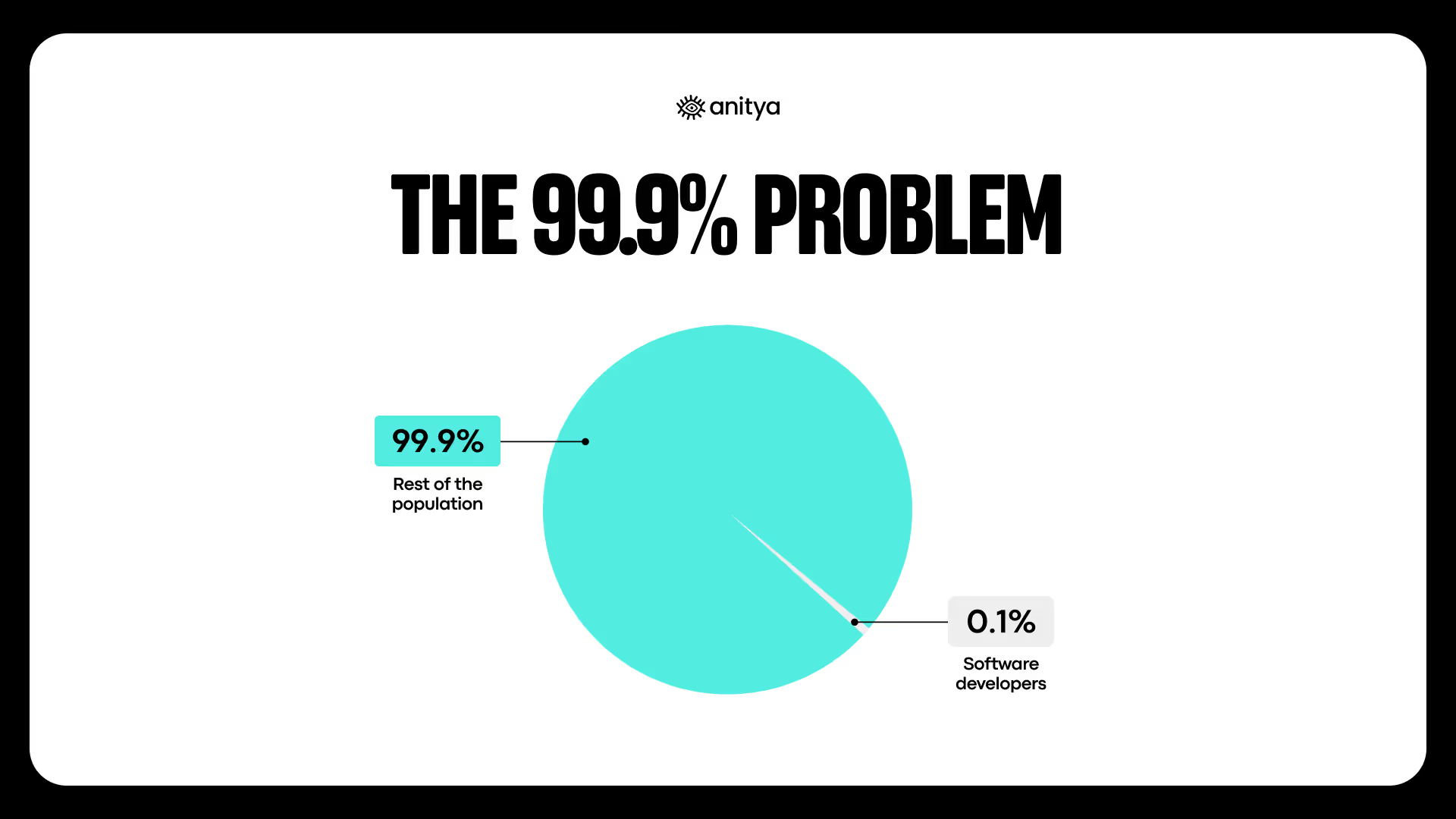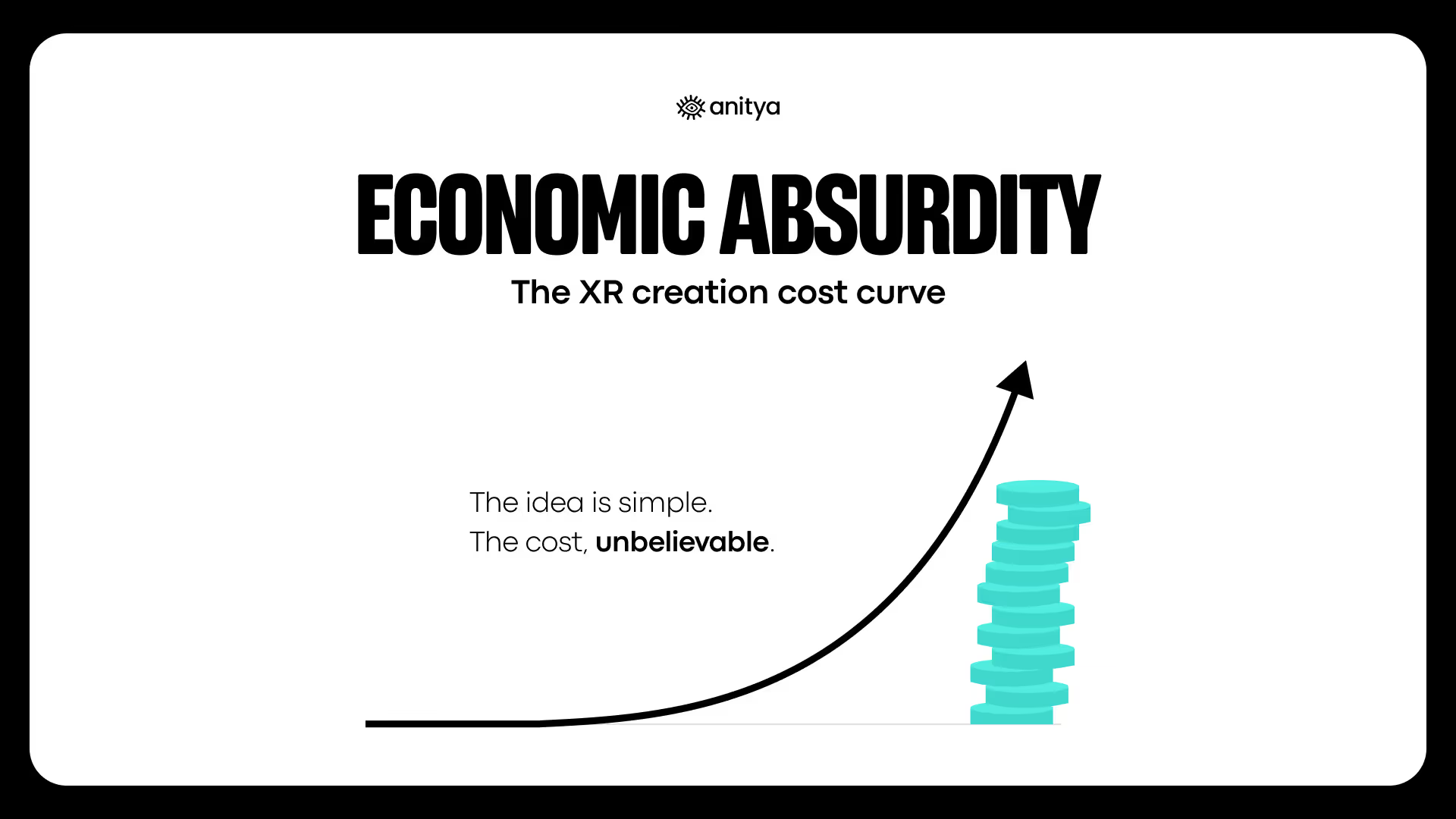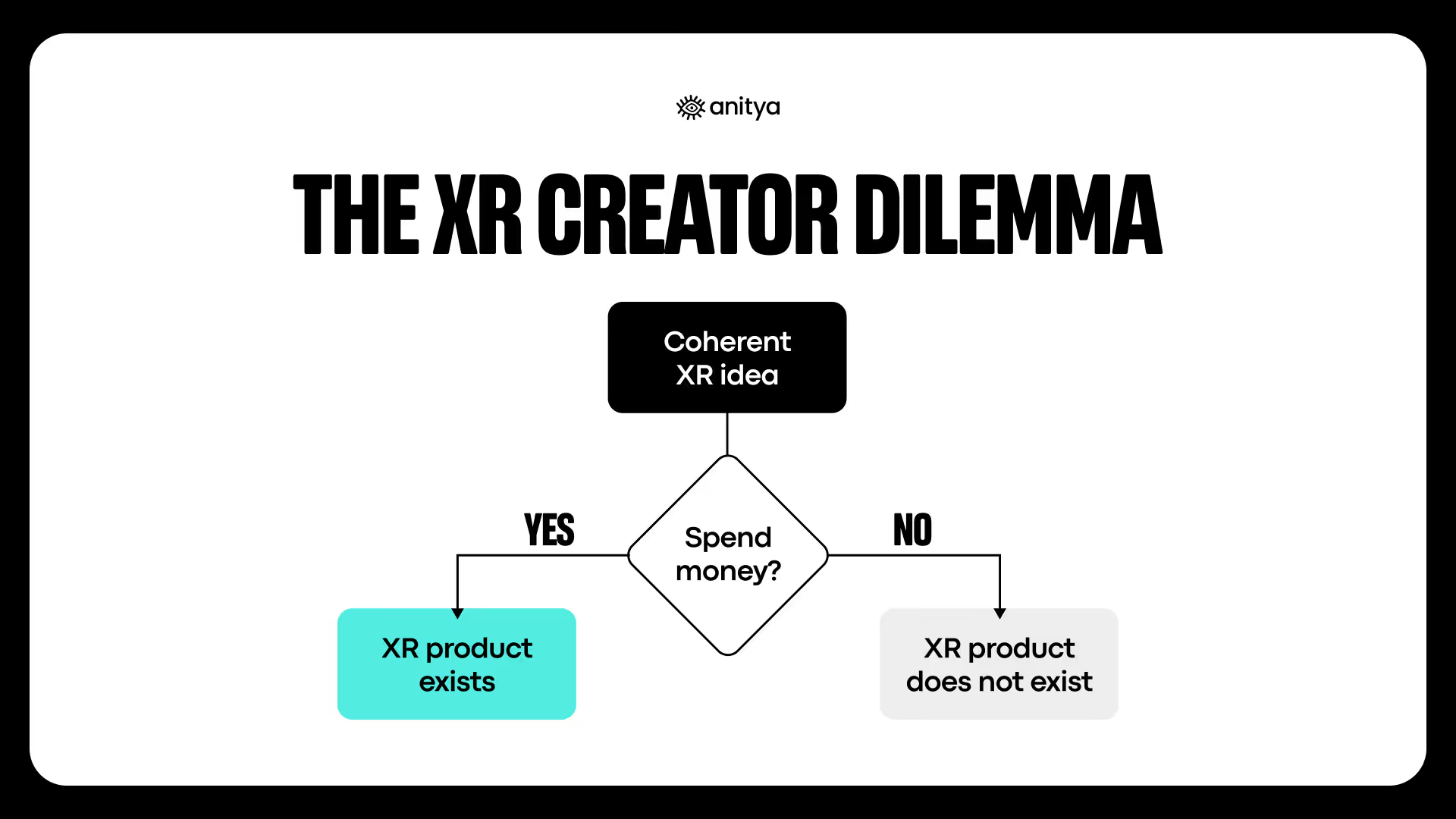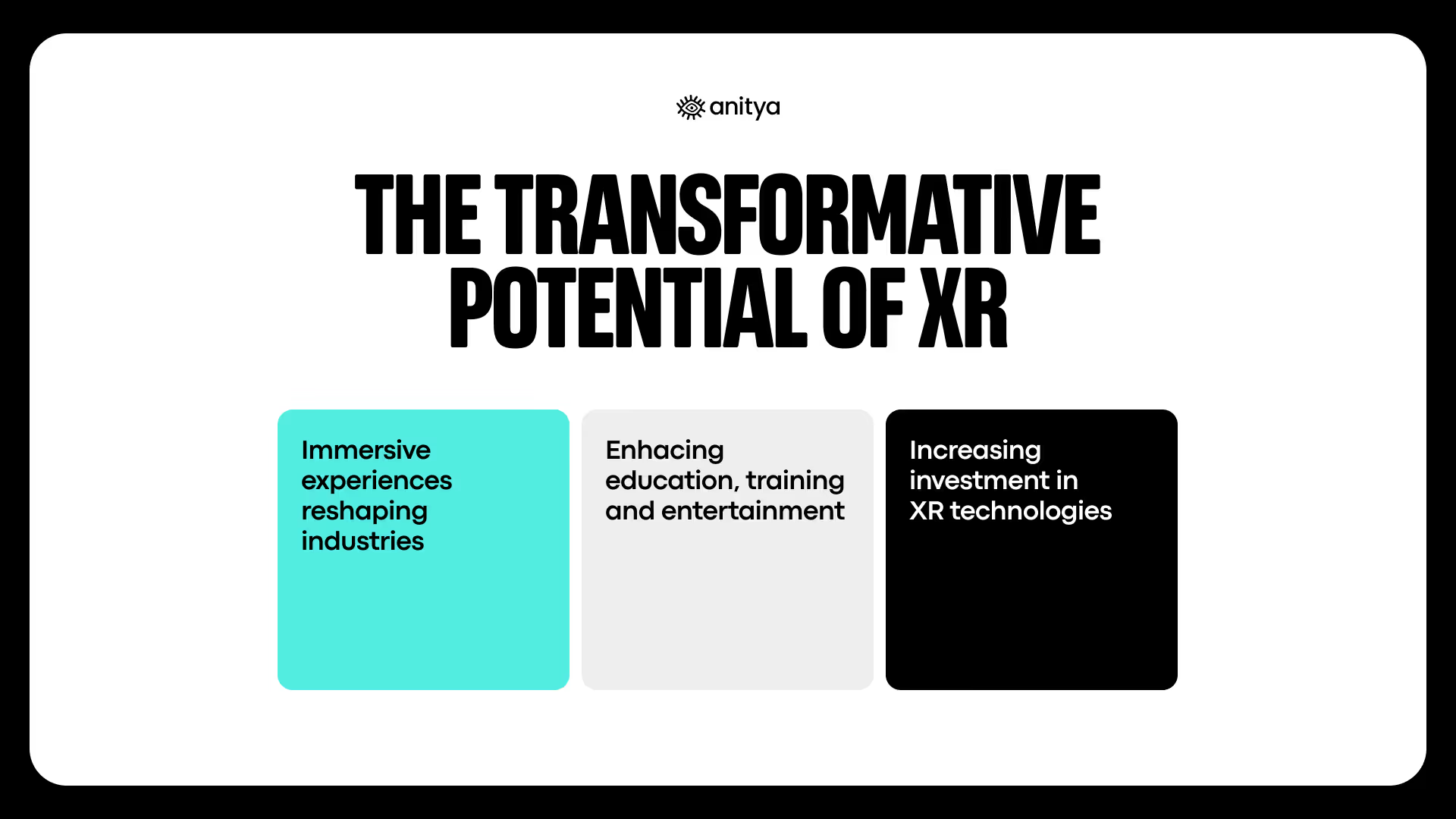The 99.9% Problem: Why 300 Million Creators Are Locked Out of the $1T Spatial Computing Revolution
The tools that built the internet were once exclusive to programmers. The same gatekeeping is happening to spatial computing, but this time, the stakes are even higher.
The Déjà Vu Moment
In 1995, building a website required intimate knowledge of HTML, CSS, and server administration. Only a tiny fraction of humanity, perhaps 0.1%,possessed the technical skills to participate in what would become the most transformative communication medium in human history. The internet's early years were dominated by computer scientists, engineers, and technical specialists who could navigate the complex requirements of web development.

Fast forward three decades, and we find ourselves at a strikingly similar inflection point, but this time the stakes are exponentially higher. Today, we stand on the precipice of the spatial computing revolution, a transformation that will fundamentally reshape how humans interact with digital information and each other.
Extended Reality (XR),encompassing virtual reality, augmented reality, and mixed reality, is projected to explode from $142.39 billion in 2023 to over $1 trillion by 2030, representing a staggering 32.9% compound annual growth rate. Yet despite this unprecedented growth trajectory, we face the same fundamental barrier that once constrained the early internet: the tools defining our spatial future remain locked behind years of technical training.
The parallel is both striking and deeply concerning. Just as the early web was built by a technical priesthood that excluded 99.9% of humanity, spatial computing is currently being shaped by an even smaller group of specialists. But unlike the web revolution, which primarily affected how we consume and share information, the spatial computing revolution will determine how we learn, work, collaborate, and experience reality itself.
The Numbers Don't Lie
Consider the stark mathematics of exclusion that define our current moment. Of the world's 8 billion people, only approximately 28.7 million work as software developers, a mere 0.36% of the global population. Even among those who attempt to learn programming, studies suggest that only 10-20% successfully acquire the skills needed for professional development.
When it comes to 3D creation specifically, the barriers become even more insurmountable. Platforms like Unity, the current industry standard for spatial content creation, require what developers themselves describe as a "steep learning curve" spanning months to years before users can create even simple interactive experiences. Unity's own learning resources acknowledge that mastering the platform requires 4-12 weeks of intensive study for basic competency, and that's for users who already possess programming fundamentals.
This technical priesthood has created an artificial scarcity in spatial content creation that defies economic logic. While the creator economy has mushroomed to encompass 50 million global creators generating $250 billion annually, the vast majority of these creative minds remain locked out of the spatial computing revolution. They can create compelling 2D content for YouTube, TikTok, and Instagram, but when it comes to building the immersive experiences that will define how we learn, work, and play in the coming decades, they hit an insurmountable wall of technical complexity.
The irony is profound and economically devastating. At the very moment when spatial computing is becoming mainstream, with Apple's Vision Pro, Meta's Quest 3, and enterprise AR adoption accelerating, the people best equipped to create compelling content for these platforms are systematically excluded from participation. We have the hardware, we have eager audiences, and we have massive budgets allocated for spatial experiences, but we're missing the most crucial element: accessible creation tools that empower the 99.9% to build the spatial experiences they envision.

The Closing Window
The window for shaping spatial computing is rapidly closing, and the implications of who gets to participate will reverberate for decades. Unlike previous technological shifts that unfolded over years, the spatial computing revolution is happening with breathtaking speed, driven by converging forces that are creating an unprecedented moment of opportunity, and urgency.
The hardware landscape has reached a tipping point, with VR leading the charge but AR representing the ultimate prize. Apple's Vision Pro, despite its premium pricing, has sold an estimated 500,000 units in its first year, establishing spatial computing as a legitimate consumer category. Meta's Quest platform has generated over $2.9 billion in content revenue as of March 2025, demonstrating robust demand for immersive experiences. But these VR successes are merely the opening act for the much larger AR revolution ahead.

While VR creates isolated immersive experiences, AR promises to overlay digital content onto the entire physical world. When AR glasses become as ubiquitous as smartphones,a transformation that industry leaders predict within the next decade, every surface, every interaction, and every moment becomes a potential canvas for spatial content. The global VR headset market is projected to grow from $9.1 billion in 2024 to $51.9 billion by 2034, but AR represents an exponentially larger opportunity as it integrates with virtually every aspect of daily life.
But hardware adoption is only part of the story. Enterprise demand for spatial experiences is exploding across industries. Fortune 500 companies are racing to implement AR training programs, virtual showrooms, and immersive collaboration tools. Educational institutions are desperately seeking ways to create engaging spatial learning experiences. Small businesses want virtual storefronts and product demonstrations. The demand exists, the budgets are allocated, but the supply of accessible creation tools remains woefully inadequate.
This supply-demand imbalance has created a perverse economic reality that stifles innovation and excludes the very people who should be leading the spatial revolution. Simple XR experiences that should cost hundreds of dollars to create instead require $50,000 to $500,000 investments in professional development teams. A marketing team that can produce compelling video content in hours finds themselves facing months-long development cycles for basic spatial experiences. An educator with transformative ideas for immersive learning must either abandon their vision or navigate complex procurement processes to hire specialized developers.
The Technical Fortress
To understand how we arrived at this moment of artificial scarcity, we must examine the historical forces that created the current gatekeeping system around spatial content creation. The tools that dominate 3D and XR development today,Unity, Unreal Engine, and their contemporaries, were never designed for the creator economy. They emerged from the gaming industry, built by developers for developers, optimized for technical sophistication rather than creative accessibility.

Unity Technologies, founded in 2004, revolutionized game development by making 3D creation more accessible than previous tools like custom C++ engines. But "more accessible" in the context of professional game development still meant requiring months of training, deep programming knowledge, and familiarity with complex technical concepts like shaders, physics systems, and optimization pipelines.
The complexity runs deeper than just learning curves. Modern 3D development requires understanding multiple interconnected systems: 3D modeling software for asset creation, programming languages for interactivity, version control systems for collaboration, deployment pipelines for different platforms, and optimization techniques for performance. A creator who wants to build a simple interactive experience must become proficient in what amounts to an entire technical ecosystem,a barrier that would be like requiring every blogger to understand server administration, database management, and network protocols.
This technical complexity has created what economists call "artificial scarcity",a situation where the primary constraint on production isn't natural resource limitations but artificially imposed barriers to entry. The raw materials for spatial content creation,creativity, storytelling ability, domain expertise, and artistic vision,exist in abundance among the global creator community. What's scarce is access to tools that can translate these abundant creative resources into spatial experiences.
The economic implications are staggering and represent a massive market failure. When a marketing team wants to create a virtual product demonstration, they face a choice between abandoning the idea or investing tens of thousands of dollars in specialized development. When an educator envisions an immersive historical experience, they must either settle for traditional media or navigate complex procurement processes to hire technical specialists. When an artist wants to create an interactive gallery, they must either learn programming or find a technical collaborator willing to translate their vision into code.
This dynamic has created a bottleneck that constrains the entire spatial computing ecosystem. Despite massive investment in XR hardware and platforms, content creation remains the limiting factor. Meta has invested billions in Quest development, Apple has launched the Vision Pro, and enterprise customers have allocated substantial budgets for spatial experiences, yet the supply of compelling content remains inadequate because the creation tools exclude 99.9% of potential creators.
The Stakes: More Than Just Business
The comparison to the early web is instructive but incomplete. When the internet was emerging, the stakes were primarily commercial,who would build the first generation of websites and online businesses. With spatial computing, the stakes are fundamentally different and far more profound. We're not just building new websites; we're constructing the foundational layer of how humans will interact with digital information for the next several decades.

Consider what's at stake: the spatial web will determine how students learn complex subjects, how workers collaborate across distances, how patients receive medical care, how artists express their creativity, and how communities gather and connect. If only a technical elite can build these experiences, we risk creating a spatial internet that reflects the perspectives, biases, and limitations of a tiny fraction of humanity. The diversity of voices, stories, and solutions that have made the 2D internet so rich and transformative will be absent from the spatial realm unless we democratize the creation tools.
The creator economy provides a compelling preview of what's possible when barriers to content creation are lowered. Goldman Sachs projects the creator economy will nearly double from $250 billion today to $480 billion by 2027, driven primarily by creators who have no formal training in media production but possess the most valuable asset of all: compelling ideas and authentic voices. These same creators,YouTubers, TikTokers, educators, artists, entrepreneurs,have spatial ideas worth building, but they're currently locked out of the tools needed to realize their visions.
The result is a creative apartheid where spatial content creation remains the exclusive domain of technical specialists. The voices, perspectives, and creative solutions that have made the 2D internet so rich and diverse are systematically excluded from spatial computing. We have teachers who understand learning better than any developer, artists who understand visual communication better than any programmer, and entrepreneurs who understand customer needs better than any technical team, yet none of them can directly translate their expertise into spatial experiences.
This exclusion isn't just inefficient,it's actively harmful to the development of spatial computing. When only technical specialists can create spatial content, the resulting experiences reflect the perspectives, assumptions, and limitations of that narrow community. The spatial internet risks becoming a sterile, technically impressive but creatively impoverished realm that fails to capture the full spectrum of human creativity and need.
The Urgency of Now
The urgency cannot be overstated. Every month that passes with spatial creation tools remaining inaccessible is a month where the spatial internet is being built by a narrow slice of humanity. The foundational experiences, interaction paradigms, and creative conventions established in these early years will shape spatial computing for decades to come. If we wait for the technical barriers to naturally erode,as they eventually did with web development,we'll miss the critical window when the spatial internet's DNA is being written.
The technical priesthood model worked adequately when 3D content creation was primarily focused on gaming and professional visualization. But as spatial computing expands into education, marketing, social interaction, and countless other domains, the limitations of this model become increasingly apparent. We need teachers creating educational experiences, marketers building brand interactions, artists crafting immersive galleries, and entrepreneurs developing spatial commerce solutions. None of these creators should be required to become programmers to realize their visions.
The question facing us is not whether spatial computing will become mainstream,that trajectory is already locked in. The question is whether the spatial internet will be built by and for everyone, or whether it will remain the exclusive domain of a technical elite. The tools and platforms that emerge in the next few years will determine which future we inhabit.
In our next article, we'll explore the breakthrough technologies and emerging platforms that are beginning to crack open this technical fortress, democratizing spatial creation in ways that could unleash the creativity of 300 million creators worldwide. The revolution is beginning,and it's happening faster than most people realize.
_________________________________________________________________________________________________________________________________________
This is Part 1 of a 3-part series on the spatial computing revolution. Part 2 will explore the democratization technologies breaking down barriers to spatial creation.
Pedro Jardim is a spatial computing entrepreneur and advocate for democratizing XR creation tools. He is the founder of anitya, a platform that enables anyone to create immersive 3D experiences without coding.
